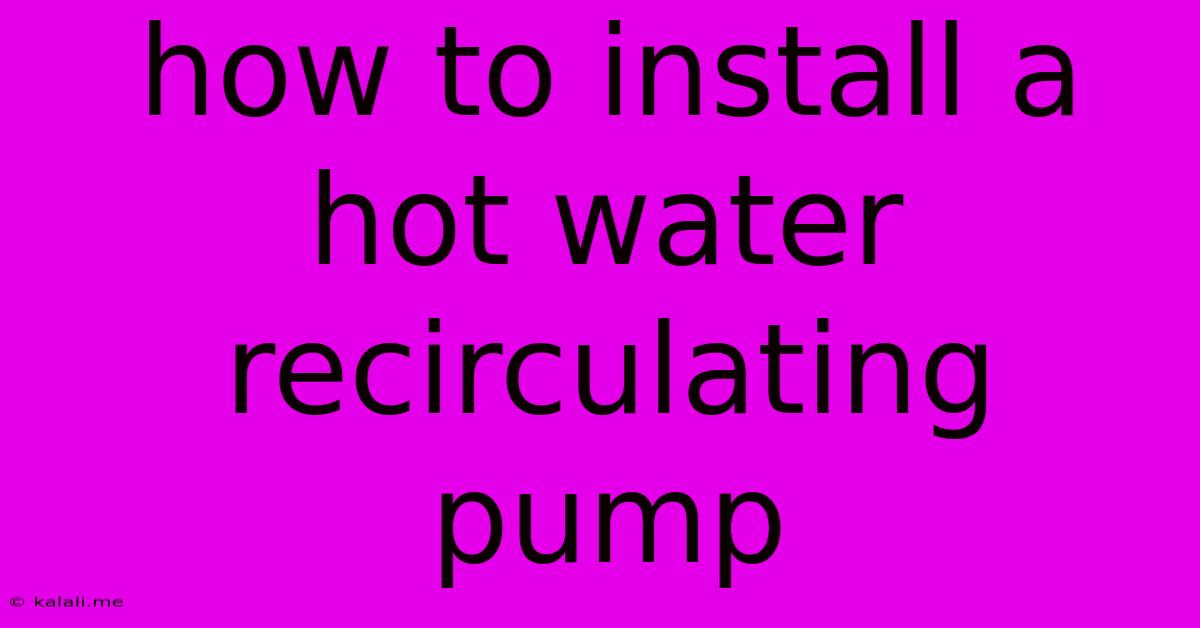How To Install A Hot Water Recirculating Pump
Kalali
Jun 01, 2025 · 4 min read

Table of Contents
How to Install a Hot Water Recirculating Pump: A Step-by-Step Guide
Meta Description: Learn how to install a hot water recirculating pump to enjoy instant hot water at your faucets. This step-by-step guide covers everything from choosing the right pump to connecting the plumbing. Say goodbye to wasted water and hello to instant hot water convenience!
Tired of waiting for hot water to reach your faucet? A hot water recirculating pump is the perfect solution. This handy device continuously circulates hot water through your pipes, providing instant hot water on demand, saving you water and energy in the process. While professional installation is always an option, many homeowners find the process manageable with the right instructions and tools. This guide will walk you through a typical installation, covering everything from selecting the right pump to making the final connections. Remember, safety is paramount. If you are uncomfortable performing any step, consult a qualified plumber.
Choosing the Right Hot Water Recirculation Pump
Before you even think about installing your pump, choose the right one for your needs. Consider these factors:
- Flow Rate: This is measured in gallons per minute (GPM) and should match your household's hot water usage. A larger house with multiple bathrooms will require a higher GPM pump.
- Pump Type: There are several types, including inline and tankless pumps. Inline pumps are typically easier to install in existing systems.
- Power Requirements: Check your electrical panel capacity and ensure you have enough amperage available.
- Noise Level: Some pumps are quieter than others. Consider this, particularly if your pump will be located near living areas.
- Features: Some advanced pumps offer features like variable speed control and timers for increased efficiency and customization.
Tools and Materials You'll Need
Before you begin, gather these necessary tools and materials:
- Hot water recirculating pump: Chosen according to your needs (see above).
- Plumbing fittings: This will depend on your existing plumbing, but you'll likely need various adaptors and connectors.
- Pipe cutters or saws: For cutting and sizing your pipes.
- Pipe thread sealant (Teflon tape): To ensure leak-free connections.
- Adjustable wrench: To tighten plumbing fittings.
- Screwdrivers: To install the pump mounting bracket (if necessary).
- Electrical tape: For electrical connections.
- Voltage tester: To ensure power is off before working with electrical components.
- Level: To ensure the pump is installed correctly.
Step-by-Step Installation Guide
This guide provides a general overview. Your specific installation may vary slightly depending on your home's plumbing configuration.
- Turn Off the Power and Water: This is crucial for safety. Turn off the power to the circuit that feeds your hot water heater and the main water supply to your house.
- Locate Installation Point: The best location is typically near the hot water heater. This minimizes the length of the recirculation loop and maximizes efficiency.
- Install the Pump: Follow the manufacturer's instructions for mounting and securing the pump. This may involve attaching a bracket to a nearby stud or wall.
- Cut and Prepare the Pipes: Carefully cut the hot water supply pipe near the water heater. Ensure clean, square cuts for optimal connections.
- Connect the Plumbing: Using the appropriate fittings, connect the pump to the cut hot water supply pipe. Apply Teflon tape to all threaded connections to prevent leaks.
- Connect the Return Line: Run a new pipe from the pump's output to a point near the furthest hot water fixture in your house. Connect this pipe to the cold water supply line using a tee fitting. This creates the recirculation loop. The return line should be insulated to reduce heat loss.
- Install the Timer or Controller (Optional): If your pump includes a timer or controller, install it according to the manufacturer's instructions. This allows you to program the pump to operate only during specific times, saving energy.
- Test for Leaks: Turn the water supply back on slowly. Carefully check all connections for leaks.
- Turn on the Power: Turn the power back on to the pump and verify it is functioning correctly.
- Check Water Temperature: Run the furthest hot water taps in your home to ensure hot water arrives quickly. Adjust the timer or controller as needed to optimize performance.
Troubleshooting
- No Hot Water: Check the power supply to the pump, water supply valves, and all connections for leaks.
- Pump is Noisy: Ensure the pump is properly mounted and secured. Excessive noise may indicate a problem with the pump itself.
- Leaks: Tighten fittings and check for any damaged pipes or connectors.
Installing a hot water recirculating pump can significantly improve your home's comfort and efficiency. Remember to follow safety precautions and consult a professional if you encounter any difficulties. By taking the time to properly plan and install your system, you’ll enjoy the convenience of instant hot water for years to come.
Latest Posts
Latest Posts
-
Business In The Front Party In Back
Jun 02, 2025
-
All I Know Is My Electric Drill Floated
Jun 02, 2025
-
What To Do After Killing First Mechanical Boss
Jun 02, 2025
-
Do Pans Need A Higher Or Lower Specific Heat
Jun 02, 2025
-
How To Get Food Colouring Off Hands
Jun 02, 2025
Related Post
Thank you for visiting our website which covers about How To Install A Hot Water Recirculating Pump . We hope the information provided has been useful to you. Feel free to contact us if you have any questions or need further assistance. See you next time and don't miss to bookmark.